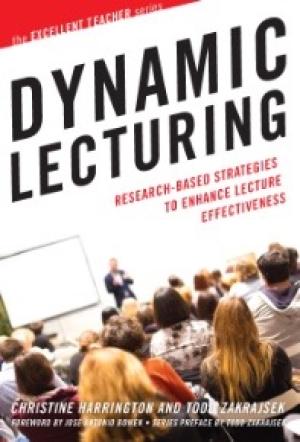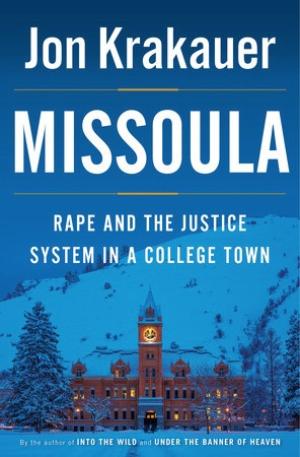Resources by Kathleen Gallagher Elkins

Against the prevailing tide in higher education, Christine Harrington and Todd Zakrajsek argue that lectures, when prepared well and incorporated appropriately, are one of the most effective ways to enhance learning. The first part of their book is focused on making this case and on delineating the different forms a lecture can take. The second part of the book focuses on ways to make lectures more effective for learners. That second part takes up the bulk of the book (7 of the 11 chapters). The third part provides tools and resources for preparing and evaluating lectures. These final two chapters give helpful rubrics, charts, and questionnaires that can easily be adapted for one’s own lectures or for evaluating others’ lectures. This book would be a useful addition to an individual professor’s library and, most especially, to a center for teaching and learning library. Both authors of Dynamic Lecturing are trained in psychology and have experience in teaching and learning and faculty development centers, so the examples are often from social science or natural science classrooms. However, many of their suggestions could easily be adapted to theology and religious studies. Using research from the scholarship of teaching and learning, they argue that lectures are efficient and effective for novice learners but are less so for expert learners (by which they mean advanced undergraduates and graduate students). This book, therefore, would be most useful for faculty who frequently teach lower-division courses for undergraduates; it could still be quite useful for those wanting to make their lectures more effective, even if they work with other learner populations and use other kinds of teaching tools. This distinction between novice and expert learners is significant in the context of theology and religious studies: in certain courses, students may enter the classroom assuming they are the experts (for example, if the course focuses on their own religious tradition, especially if the professor is not another “insider”). Harrington and Zakrajsek’s discussion of techniques like pre-testing may be a way to address this unique dynamic: if a student took a pre-test and found that they did not know as much as they thought they knew, they might find themselves more open to learning from a professor’s lecture. As their title suggests, this is not a book about individual teaching choices, but rather is focused on research-based strategies: nearly every paragraph has multiple citations that refer the reader to studies done on teaching and learning. A bibliography accompanies each chapter, so references are easy to track down, if desired. The studies are often explained well, so the reader knows what the research suggests; there are times, however, when the conclusions seem overstated. For example, a study used to argue that lectures are more helpful than active learning sessions to novice learners is explained in a parenthetical note: 88% of students agreed or strongly agreed that a lecture helped them learn course content compared with 49% of students who agreed or strongly agreed that active learning sessions helped them learn course content (10). Self-reporting is not the same as demonstrating mastery of the content. In other places, the authors note that students are not always the best judges of their own learning (see, for example, studies on learners’ overconfidence [115]). The research cited throughout the book is not limited to self-reporting and includes very helpful data on what promotes student engagement and learning.

Jon Krakauer’s book on the epidemic of sexual assaults on American college campuses is hard to put down, both because it is incredibly well-written and engaging, but also because it is so alarming. For the faculty member who is already aware of the problem (either from a statistical vantage point or from hearing the experiences of survivors on her or his own campus), some of the information presented is not surprising. The scope of the issue is quite shocking, however: Missoula, home of the University of Montana, is the focus of Krakauer’s case study and one gets the sense that this college town is especially unsafe. Towards the end of the book, however, Krakauer demonstrate that Missoula’s rape statistics are actually typical – perhaps even lower than the national average. Even though the problem presented is horrifying, Missoula is not even the worse case scenario. Through interviews and legal testimony, Krakauer narrates the stories of several college-aged women who were sexually assaulted while they were students. Most of the accused rapists were members of the football team, so part of the story concerns the untouchable status of campus athletic teams (or, at least, certain high-profile athletic teams). But sports are not the only unjust system implicated here: Krakauer looks unflinchingly at the ways that administrators protect colleges from litigation, often at the expense of victims. He similarly criticizes the legal system for re-traumatizing victims and for consistently doubting women’s testimony when they come forward. Krakauer’s accessible explanations of technical matters are very helpful: for example, he explains the different burdens of proof that apply on- and off-campus. A college or university is required by the U.S. Department of Education to use a “preponderance of evidence” standard as its burden of proof when adjudicating sexual assault accusations, while the criminal justice system uses the “beyond a reasonable doubt” standard (179). Thus, a rapist may be found guilty in an on-campus case and expelled, even while the same evidence might not have resulted in a guilty verdict or prison time in the state’s criminal justice system. As another example, Krakauer uses psychiatrist Judith Herman’s foundational work to explain that traumatized people often act in bewildering ways that do not make sense to the outside world (perhaps by contacting the perpetrator or by continuing to attend class after experiencing violent trauma; moreover, the memories of a traumatic experience can be confusing and non-linear). Although these behaviors seem to indicate to others that “nothing happened” or “the experience must not have been that bad,” Krakauer (via Herman) shows that these are utterly typical behaviors of a traumatized person. Trauma so reorients a person that the behaviors a person displays in the aftermath can be counterintuitive to what non-traumatized people expect. This book should be required reading for faculty and especially for administrators who adjudicate sexual assault cases on college campuses; it would probably be useful for those in law enforcement, too. Missoula would also be excellent for campuses that have required first-year or campus-wide reading programs, as it forces us to consider the realities that victims face on campus and to realize that judicial systems, both on- and off-campus, can and must do better.